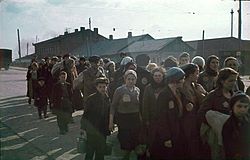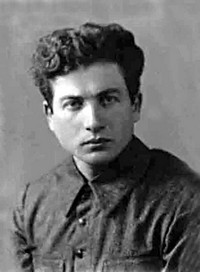
The Reichskommissariat Ostland was established by Nazi Germany in 1941 during World War II. It became the civilian occupation regime in Lithuania, Latvia, Estonia, and the western part of Byelorussian SSR. German planning documents initially referred to an equivalent Reichskommissariat Baltenland. The political organization for this territory – after an initial period of military administration before its establishment – involved a German civilian administration, nominally under the authority of the Reich Ministry for the Occupied Eastern Territories led by Nazi ideologist Alfred Rosenberg, but actually controlled by the Nazi official Hinrich Lohse, its appointed Reichskommissar.

The ghetto uprisings during World War II were a series of armed revolts against the regime of Nazi Germany between 1941 and 1943 in the newly established Jewish ghettos across Nazi-occupied Europe. Following the German and Soviet invasion of Poland in September 1939, Polish Jews were targeted from the outset. Within months inside occupied Poland, the Germans created hundreds of ghettos in which they forced the Jews to live. The new ghettos were part of the German official policy of removing Jews from public life with the aim of economic exploitation. The combination of excess numbers of inmates, unsanitary conditions and lack of food resulted in a high death rate among them. In most cities the Jewish underground resistance movements developed almost instantly, although ghettoization had severely limited their access to resources.

Maly Trostenets is a village near Minsk in Belarus, formerly the Byelorussian Soviet Socialist Republic. During Nazi Germany's occupation of the area during World War II, the village became the location of a Nazi extermination site.

The Vilna Ghetto was a World War II Jewish ghetto established and operated by Nazi Germany in the city of Vilnius in the modern country of Lithuania, at the time part of the Nazi-administered Reichskommissariat Ostland.
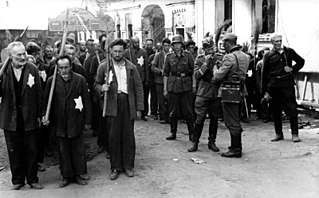
The German invasion of the Soviet Union started on 22 June 1941 and led to a German military occupation of Byelorussia until it was fully liberated in August 1944 as a result of Operation Bagration. The western parts of Byelorussia became part of the Reichskommissariat Ostland in 1941, and in 1943, the German authorities allowed local collaborators to set up a regional government, the Belarusian Central Rada, that lasted until the Soviets reestablished control over the region. Altogether, more than two million people were killed in Belarus during the three years of Nazi occupation, around a quarter of the region's population, or even as high as three million killed or thirty percent of the population, including 500,000 to 550,000 Jews as part of the Holocaust in Belarus. In total, on the territory of modern Belarus, more than 9,200 villages and settlements, and 682 thousand buildings were destroyed and burned, with some settlements burned several times.

When the Second World War in Europe began, the territory which now forms the country of Belarus was divided between the Soviet Union and the Second Polish Republic. The borders of Soviet Belarus were greatly expanded in the Soviet invasion of Poland of 1939. In 1941, the country was occupied by Nazi Germany. Following the German military disasters at Stalingrad and Kursk, the collaborationist Belarusian Central Council (BCC) was formed by the Germans in order to raise local support for their anti-Soviet operations. The BCC in turn formed the twenty-thousand strong Belarusian Home Defence (BKA), active from 23 February 1944 to 28 April 1945. Assistance to collaborators was offered by the local Soviet administrative governments, and prewar public organizations including the former Soviet Belarusian Youth. The country was soon retaken by the Red Army in 1944. Devastated by the war, Belarus lost significant populations and economic resources. Many battles occurred in Belarusian territory. Belarusians also participated in the advance towards Berlin.

Jewish resistance under Nazi rule took various forms of organized underground activities conducted against German occupation regimes in Europe by Jews during World War II. According to historian Yehuda Bauer, Jewish resistance was defined as actions that were taken against all laws and actions acted by Germans. The term is particularly connected with the Holocaust and includes a multitude of different social responses by those oppressed, as well as both passive and armed resistance conducted by Jews themselves.

The Holocaust in Poland was the ghettoization, robbery, deportation, and murder of Jews in occupied Poland, organized by Nazi Germany. Three million Polish Jews were murdered, primarily at the Chelmno, Belzec, Sobibor, Treblinka, and Auschwitz II–Birkenau extermination camps, representing half of all Jews murdered during the Europe-wide Holocaust.

Jewish partisans were fighters in irregular military groups participating in the Jewish resistance movement against Nazi Germany and its collaborators during World War II.

Wilhelm Kube was a Nazi official and German politician. He was an important figure in the German Christian movement during the early years of Nazi rule. During the war he became a senior official in the occupation government of the Soviet Union, achieving the rank of Generalkommissar for Generalbezirk Weißruthenien. He was assassinated by a Soviet partisan in Minsk in 1943 after his participation in the Holocaust, triggering brutal reprisals against the city's citizens.
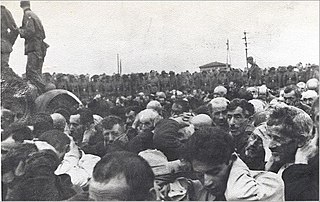
The Białystok Ghetto was a Nazi ghetto set up by the German SS between July 26 and early August 1941 in the newly formed District of Bialystok within occupied Poland. About 50,000 Jews from the vicinity of Białystok and the surrounding region were confined into a small area of the city, which was turned into the district's capital. The ghetto was split in two by the Biała River running through it. Most inmates were put to work in the slave-labor enterprises for the German war effort, primarily in large textile, shoe and chemical companies operating inside and outside its boundaries. The ghetto was liquidated in November 1943. Its inhabitants were transported in Holocaust trains to the Majdanek concentration camp and Treblinka extermination camps. Only a few hundred survived the war, either by hiding in the Polish sector of the city, escape following the Bialystok Ghetto Uprising, or by surviving the camps.

Ivyanyets or Ivenets, is an urban-type settlement in Valozhyn District, Minsk Region, Belarus. It is located 56 kilometers (35 mi) west of Minsk. In 2017, its population was 4,206. As of 2023, it has a population of 3,874.

Janowska concentration camp was a German Nazi concentration camp combining elements of labor, transit, and extermination camps. It was established in September 1941 on the outskirts of Lwów in what had become, after the German invasion, the General Government. The camp was named after the nearby street Janowska in Lwów of the interwar Second Polish Republic.
The Holocaust in Belarus refers to the systematic extermination of Jews living in the Byelorussian Soviet Socialist Republic during its occupation by Nazi Germany in World War II. It is estimated that roughly 800,000 Belarusian Jews were murdered during the Holocaust. However, other estimates place the number of Jews killed between 500,000 and 550,000.
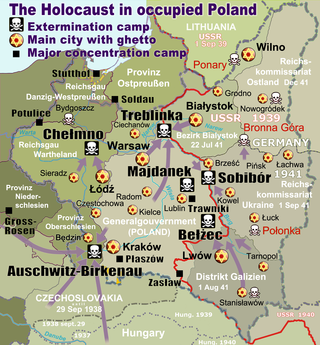
ŁachwaGhetto was a Nazi ghetto in Łachwa, Poland during World War II. The ghetto was created with the aim of persecution and exploitation of the local Jews. The ghetto existed until September 1942. One of the first Jewish ghetto uprisings had happened there.

The Słonim Ghetto was a Nazi ghetto established in 1941 by the SS in Slonim, Western Belarus during World War II. Prior to 1939, the town (Słonim) was part of the Second Polish Republic. The town was captured in late June 1941 by the Wehrmacht in the early stages of Operation Barbarossa. Anti-Jewish measures were promptly put into place, and a barb-wire surrounded ghetto had been created by 12 July. The killings of Jews by mobile extermination squads began almost immediately. Mass killings took place in July and November. The survivors were used as slave labor. After each killing, significant looting by the Nazis occurred. A Judenrat was established to pay a large ransom; after paying out 2 million roubles of gold, its members were then executed. In March 1942, ghettos in the surrounding areas were merged into the Słonim ghetto.
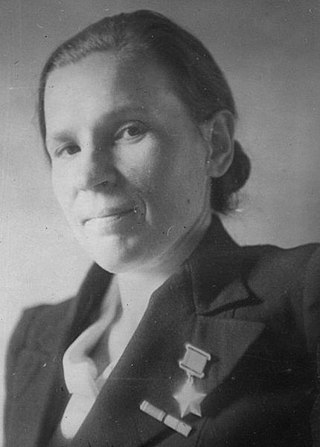
Mariya Borisovna Osipova was a Soviet Belarusian partisan who provided Yelena Mazanik with the bomb she used to kill Wilhelm Kube, a high-ranking SS officer and the General-Commissar of Nazi-occupied Belarus. For doing so, Osipova and her co-conspirators were awarded the title Hero of the Soviet Union on 29 October 1943.

The Rakaŭ Ghetto was established on 21 August 1941 in Rakaŭ, in the Byelorussian SSR, soon after the city's capture by Nazi Germany during Operation Barbarossa. An estimated 1,050 Jews were killed in the ghetto between its creation on 21 August 1941 and its liquidation on 4 February 1942.

The Navahrudak Ghetto was established in December 1941 in Navahrudak, in the Byelorussian SSR, during the Holocaust. Almost all of its residents were killed - only 350 survived, and 10,000 perished.

Generalbezirk Weißruthenien was one of the four administrative subdivisions of Reichskommissariat Ostland, the 1941–1945 civilian occupation regime established by Nazi Germany for the administration of the three Baltic countries and the western part of the Byelorussian SSR.

